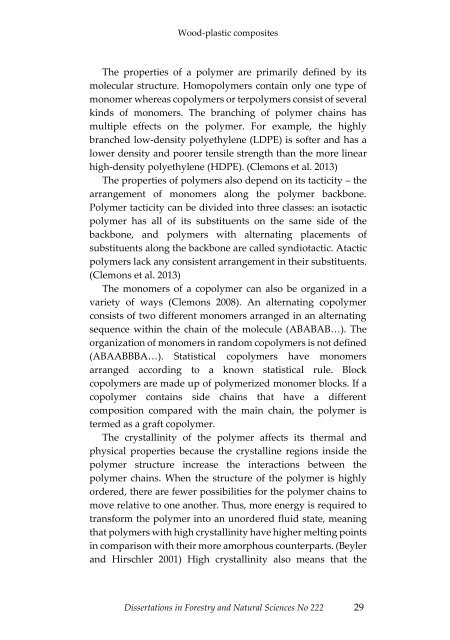Dissertations in Forestry and Natural Sciences
24lYKFN
24lYKFN
You also want an ePaper? Increase the reach of your titles
YUMPU automatically turns print PDFs into web optimized ePapers that Google loves.
Wood-plastic composites<br />
The properties of a polymer are primarily def<strong>in</strong>ed by its<br />
molecular structure. Homopolymers conta<strong>in</strong> only one type of<br />
monomer whereas copolymers or terpolymers consist of several<br />
k<strong>in</strong>ds of monomers. The branch<strong>in</strong>g of polymer cha<strong>in</strong>s has<br />
multiple effects on the polymer. For example, the highly<br />
branched low-density polyethylene (LDPE) is softer <strong>and</strong> has a<br />
lower density <strong>and</strong> poorer tensile strength than the more l<strong>in</strong>ear<br />
high-density polyethylene (HDPE). (Clemons et al. 2013)<br />
The properties of polymers also depend on its tacticity – the<br />
arrangement of monomers along the polymer backbone.<br />
Polymer tacticity can be divided <strong>in</strong>to three classes: an isotactic<br />
polymer has all of its substituents on the same side of the<br />
backbone, <strong>and</strong> polymers with alternat<strong>in</strong>g placements of<br />
substituents along the backbone are called syndiotactic. Atactic<br />
polymers lack any consistent arrangement <strong>in</strong> their substituents.<br />
(Clemons et al. 2013)<br />
The monomers of a copolymer can also be organized <strong>in</strong> a<br />
variety of ways (Clemons 2008). An alternat<strong>in</strong>g copolymer<br />
consists of two different monomers arranged <strong>in</strong> an alternat<strong>in</strong>g<br />
sequence with<strong>in</strong> the cha<strong>in</strong> of the molecule (ABABAB…). The<br />
organization of monomers <strong>in</strong> r<strong>and</strong>om copolymers is not def<strong>in</strong>ed<br />
(ABAABBBA…). Statistical copolymers have monomers<br />
arranged accord<strong>in</strong>g to a known statistical rule. Block<br />
copolymers are made up of polymerized monomer blocks. If a<br />
copolymer conta<strong>in</strong>s side cha<strong>in</strong>s that have a different<br />
composition compared with the ma<strong>in</strong> cha<strong>in</strong>, the polymer is<br />
termed as a graft copolymer.<br />
The crystall<strong>in</strong>ity of the polymer affects its thermal <strong>and</strong><br />
physical properties because the crystall<strong>in</strong>e regions <strong>in</strong>side the<br />
polymer structure <strong>in</strong>crease the <strong>in</strong>teractions between the<br />
polymer cha<strong>in</strong>s. When the structure of the polymer is highly<br />
ordered, there are fewer possibilities for the polymer cha<strong>in</strong>s to<br />
move relative to one another. Thus, more energy is required to<br />
transform the polymer <strong>in</strong>to an unordered fluid state, mean<strong>in</strong>g<br />
that polymers with high crystall<strong>in</strong>ity have higher melt<strong>in</strong>g po<strong>in</strong>ts<br />
<strong>in</strong> comparison with their more amorphous counterparts. (Beyler<br />
<strong>and</strong> Hirschler 2001) High crystall<strong>in</strong>ity also means that the<br />
<strong>Dissertations</strong> <strong>in</strong> <strong>Forestry</strong> <strong>and</strong> <strong>Natural</strong> <strong>Sciences</strong> No 222 29



